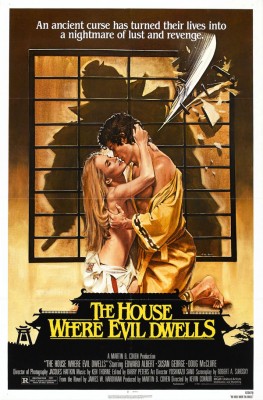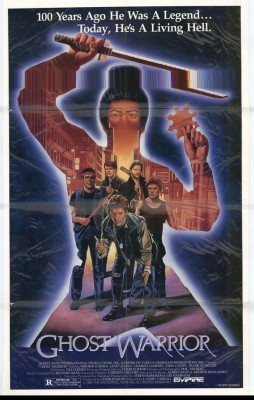| Reviews & Columns |
|
Reviews DVD TV on DVD Blu-ray 4K UHD International DVDs In Theaters Reviews by Studio Video Games Features Collector Series DVDs Easter Egg Database Interviews DVD Talk Radio Feature Articles Columns Anime Talk DVD Savant Horror DVDs The M.O.D. Squad Art House HD Talk Silent DVD
|
DVD Talk Forum |
|
|
| Resources |
|
DVD Price Search Customer Service #'s RCE Info Links |
|
Columns
|
|
|
House Where Evil Dwells / Ghost Warrior, The
The House Where Evil Dwells is, essentially, "Za Amitibiru Horaa," i.e., The Amityville Horror (1979), Japanese-style, and probably also inspired by the huge success of the novel and miniseries adaption of James Clavell's Shogun, which sparked a big if short-lived interest in all things Japan.
An American writer, Ted Fletcher (Edward Albert), his wife, Laura (Susan George), and 12-year-old daughter, Amy (Amy Barrett), move into a dreamy traditional Japanese house in rural Kyoto Prefecture. Arranged by Ted's American diplomat friend, Alex Curtis (Doug McClure), the unusually spacious house is a steal, renting for just $250/month.
What the Fletchers don't realize is that 142 years earlier a samurai, Shigero (Tsuyuki Sasaki), arrived home one evening to find his wife, O-tami (Mako Hattori), bedding down with another man, Masanori (Toshiya Maruyama). In a jealous rage he murdered them both (decapitating Masanori) before committing seppuku. Their ghosts still haunt the place, resulting in spectral possession and other mischief along the lines of Amityville.
An American-Japanese co-production, the film was a directed by Kevin Connor, best remembered for his quaintly charming fantasy adventures of the 1970s, especially The Land That Time Forgot (1975) and its sequel, The People That Time Forgot (1977), both featuring actor McClure, who became a beefy, genial regular in Connor's films.
Unfortunately, The House Where Evil Dwells is about as scary as Hello Kitty. The big problem is that the three ghosts, inexplicably a team in the Great Beyond, are too literal and reveal their presence to the audience - but not the Fletchers - too early in the story.
A prologue featuring the murders in 1840 sets everything up, but the film would have worked much better if the audience had to figure things out along with the Fletchers. Instead, the ghosts literally materialize outside Ted and Laura's bedroom window the very night they arrive, hovering about them for the rest of the picture. The Fletchers can't see them (until midpoint, when for no clear reason Ted can sometimes see them) but the movie audience can, all too clearly. This proves a frustrating contrivance: the audience understands exactly what's happening but the Fletchers are clueless for most of the film. Instead of generating suspense this device is merely irritating. Later, when they do finally begin to catch on, they make that fatal decision all stupid people do in haunted house movies: stay put.
The ghosts are also far too clearly seen, transparent but otherwise with a kind of Blithe Spirit reality instead of the subtler, more ambiguous style one associates with the best ghost story movies (e.g., The Haunting, The Changeling, etc.) Instead of "What's going on here?" the audience is wondering, "When are the Fletchers finally grasp the obvious?" The ghostly effects were created using a German technique called Shauftausen, which sounds like a beam-splitter effect enabling the Japanese and American characters to act simultaneously if spatially separately, without the need of post-production optical effects.
Connor apparently felt the producers damaged the film by re-cutting in such a way as to focus on its more lurid elements, leaving out a lot of relationship issues involving the Ted and Laura characters. There's some clear evidence of this, references to events the audience never sees, and the movie is certainly inconsistent in tone, with extremely mild horror elements contrasting some graphic violence and sex scenes. (Note the strange poster design, emphasizing the latter.)
On the plus side, The House Where Evil Dwells undeniably offers a picturesque setting. Earlier video transfers of the film (I can't recall whether I first saw this on VHS or cable television) were dark and unattractive, but Shout!'s new 1080p transfer is superb, really showing off the lush green countryside and "exotic," tantalizing western Japan. The first third of the picture, more than The Amityville Horror, succeeds in showing the family setting off on an exciting adventure the movie audience vicariously experiences. Too bad the ghosts show up to spoil all the fun.
The bottom of the bill, Ghost Warrior (1984), is another variation of the old sci-fi chestnut in which a monster or primitive man, kept in a state of suspended animation (often frozen in ice) for eons, is revived in our modern world. In Curse of the Faceless Man (1958), for instance, it was an Etruscan gladiator unearthed in Pompeii, while in Dinosaurus! (1960) it was a playful Neanderthal, in The Beast from 20,000 Fathoms (1953) it was a "Rhedosaurus" trapped in Arctic Ice and awakened via atomic testing. A much more serious and thoughtful (though still flawed) adaptation of this idea was Iceman, also 1984.
In Ghost Warrior the reanimated subject is a 16th century samurai warrior, Yoshimitsu, played by Hiroshi Fujioka. The unusually bushy-haired, bushy eyebrowed Fujioka was famous in his native Japan as the star of the wildly popular superhero TV series Kamen Rider, which led to roles in many big ‘70s films including The Submersion of Japan (1973), ESPY (1974), Zero Pilot (1976), and High Seas Hijack (1977). He's still active today, and a fixture on Japanese variety shows.
In the movie's prologue, Yoshimitsu is shot with an arrow in what appears to be the Japan Alps, falling off a cliff and through the ice of a frozen lake. Centuries later, skiers, a young couple, discover his frozen remains, which are shipped to the California Institute of Cryosurgery Research. There, Dr. Alan Richards (John Calvin) successfully revives him, with Japanese history expert (so-called) Chris Welles (Janet Julian) brought in to assist with the reanimated warrior. She begins to bond with the understandably bemused samurai, but late one night a greedy orderly, intent on stealing Yoshimitsu's priceless swords, breaks into his room. The samurai kills him, making a break for downtown Los Angeles. There he comes to the rescue of an elderly African-American, Willie Walsh (Charles Lampkin*), instinctively wounding the street gang planning on robbing the man. Soon enough there's a dragnet out for what police assume is a sword-brandishing madman.
Ghost Warrior works through this tried-and-true plot in the usual ways. At times the screenplay has little flashes of cleverness, such as customers at a sushi shop where Willie takes Yoshimitsu mistaking him for the famous Japanese star Toshiro Mifune.
However, the movie is so profoundly illogical that it vaporizes all invitations to suspend disbelief. To begin with, why would the frozen body of a Japanese samurai, found in Japan by Japanese skiers, be shipped off to America without so much as a single Japanese scientific or historical consultant and/or official government representative? In the movie, only Chris Welles in brought it, and she barely speaks Japanese at all. When Yoshimitsu first regains consciousness and begins yammering, Dr. Richards asks Chris, "What's he saying?" Her helpful answer? "I can't make it out."
(Her level of Japanese is inconsistent, too. At the end of the film she perfectly translates Yoshimitsu's lengthy monologue, while in other scenes doesn't seem to comprehend everyday words. In any case a 400-year-old samurai wouldn't talk in contemporary Japanese anyway, no more than an Englishman from Shakespeare's time would use modern jargon.)
The Institute appears to be somewhere in the West Valley, 30 or more miles northwest of the city, and yet after escaping Yoshimitsu walks all the way to downtown Los Angeles, crossing several freeways and man-made riverbeds unnoticed. Later he turns up in another part of the city, at the Pan-Pacific Auditorium, near Park La Brea on Beverly Boulevard, miles away. Still later, on horseback, he makes it all the way to the Pacific Ocean despite police helicopters and dozens of officers searching for him. You'd think a samurai in full armor riding a white stallion would be easier to spot.
Ghost Warrior's worst offense, probably unintentional, is that in modeling itself after earlier movies about de-thawed monsters and cavemen, the script treats Yoshimitsu rather like an inarticulate imbecile when, in fact, samurai were typically highly educated and cultured.
Once revived, he's seemingly kept in a spare office that's practically a storage room, with little thought given to slowly acclimating him with the modern (and western) world, let alone communicating with him beyond Chris's rudimentary Japanese. You'd think a living samurai would be big news demanding a huge team of linguists, historians, and whatnot, but Dr. Richards neither makes any press announcement nor does he offer any reason to keep the achievement secret. Instead, they pretty much just stick him in a closet.
Video & Audio
Licensed from MGM (House was originally a United Artists release; Ghost Warrior from Empire Pictures), both movies look great, especially the former, which has really rich colors and excellent high-def resolution. House is in 1.78:1 widescreen (approximating its 1.85:1 OAR) and Ghost Warrior is 1.85:1. House is mono, the latter stereo, both DTS-HD Master Audio with optional English subtitles. (The opening scenes of Ghost Warrior, in Japanese, are automatically subtitled. On a single, region A-encoded disc.
Extra Features
The only supplements are trailers.
Parting Thoughts
Fans of cross-cultural, Japan-related movies will want to see these, while more general horror and exploitation mavens probably will find little to like. Definitely outré, this double feature set is a Rent It.
* A pioneering African-American in music (he conducted Paul Robeson in concert and wrote piano concertos) and art of spoken word, Lampkin taught music while acting, appearing mostly on television but with strangely varied movie credits including Arch Obler's Five (1952), his film debut, and the Blaxploitation classic Hammer (1972).
Stuart Galbraith IV is the Kyoto-based film historian and publisher-editor of World Cinema Paradise. His new documentary and latest audio commentary, for the British Film Institute's Blu-ray of Rashomon, and commentary track for Arrow Video's Battles without Honor and Humanity are newly available.
|
| Popular Reviews |
| Sponsored Links |
|
|
| Sponsored Links |
|
|
| Release List | Reviews | Shop | Newsletter | Forum | DVD Giveaways | Blu-Ray | Advertise |
|
Copyright 2024 DVDTalk.com All Rights Reserved. Legal Info, Privacy Policy, Terms of Use,
Manage Preferences,
Your Privacy Choices | |||||||
















